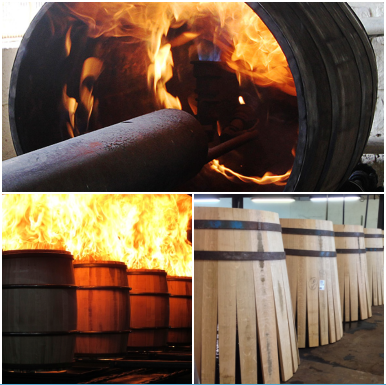Following my last post, Ask me Anything – Boozy Edition !, I got some great questions from you guys and answered a few of them below. I really enjoyed answering all your questions so please keep ’em coming! Cheers 🙂
- WHAT IS CHARRING AND TOASTING?
Toasting and charring are two distinct types of burning procedures barrel makers or coopers use when crafting their barrels. The fundamental variable between the two is the degree to which the wood is burned. And while the purpose of charring seems sort of intuitive—a charred surface yields a smoky flavour right…? The effects are in fact far more complicated.

Range of aromas produced is dependent on the level of toasting and charring.
The insides of a charred barrel often resemble the remains of a campfire or burnt toast – the burn level is extreme! The charred or burnt layers of wood act as a carbon filter extracting the harsher elements in the liquor resulting in a smoother, mellower flavour over time. The extreme heat causes caramelization of the wood sugars which imparts sweet flavours like toffee and honey into the whisky as well as a much darker hue.
Toasted barrels on the other hand are heated much more gently, resulting in a dark brown toast rather than a blackened char. Toasted barrels add a bit more vanilla flavour and are slightly sharper on the tongue as the sugars haven’t had time to caramelize (since the wood hasn’t been burned to a crisp!) They also do not impart as much colour into the spirit, resulting in a lighter coloured spirit.

2. SINCE BARRELS ARE TOASTED OVER A LIVE FIRE WHEN THEY ARE MADE, WOULDN’T THE BARREL JUST BURN UP?
It certainly seems like a barrel could since temperature of the fire used for the process can reach 430°C to 540°C! The inside of a lightly toasted barrel is usually heated for approximately 30 minutes and heavily toasted barrel for up to 60 minutes. Barrel coopers are very highly skilled and careful during this process. To keep barrels from burning completely, the cooper often mops the outside of the barrel with a wet rag while the inside is toasting.
3. DOES WHISKY HAVE A VINTAGE?
Years often appear on whiskey bottles. They may include year of distillation or year of bottling and sometimes both. After a bit of math, the year should equal your age statement. But unlike Wines, whisky does not mature or undergo any changes in the bottle. The bigger question is why?
During maturation in casks and barrels the spirit interacts with the wood to produce flavour molecules. Once removed from the barrel and bottled, all these reactions stop. Since whisky is distilled to a very high alcohol concentration (above 50% abv), it’s impossible for any living organisms to survive this highly alcoholic environment thus halting any possibilities for further changes to the whisky. This means that even if you keep a 10-year-old bottle for 100 years, it will always remain a 10-year-old whisky. If the bottle is kept out of direct heat and sunlight, the whisky will neither improve nor deteriorate, even if it is opened. Whisky is also blended to ensure consistency which is an important skill of the master blender so that your favorite bottle of whisky taste the same every time you buy it!

Old and Rare – Tomatin 1996 to Robertson’s BEB from the 1930s…
Dates and years are important when buying or collecting old and rare bottles of whisky. These whisky expressions are usually those that are produced as few hundred bottles or less, often sold through auctions and can go up to a few hundred $ a bottle!
Well written 🙂
LikeLiked by 1 person
Very insightful, thank you!
LikeLiked by 1 person
Thanks Keshav!
LikeLike